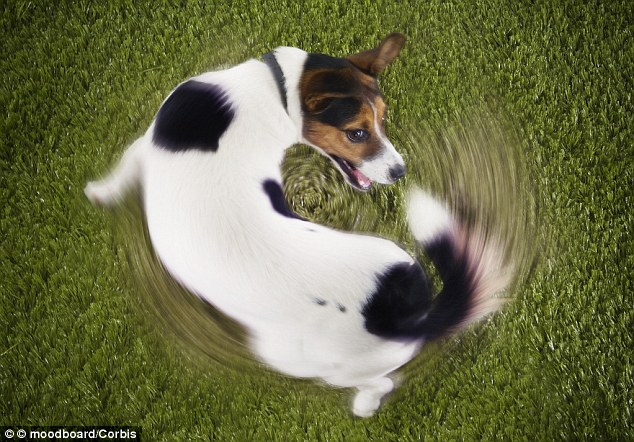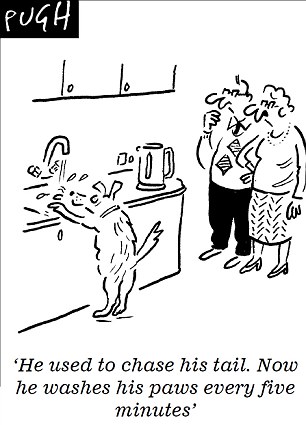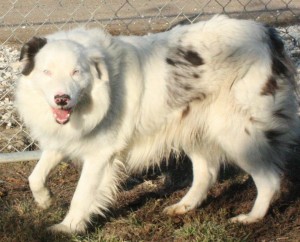Since I get this subject brought up often about deaf dogs chasing shadows, lights, and even their own tails, I thought I would share this article from the Daily Mail UK. We do list many deaf Aussie Shepherds along with deaf border collies and other deaf dogs on adoptable deaf dog page who experience mild to heavy Obsessive Compulsive Disorder (ODC). In many of my emails I read about deaf dogs exhibiting not only OCD but combined with separation anxiety which is enough to cause a deaf dog owner to be completely stressed out. According to this article it could be as simple as adding high quality vitamins to your dogs food to possibly lessen OCD behavior.
Because I hear concerns about OCD in deaf dogs so often, I do not recommend using any kind of light such as a laser light or a flash light as a training tool with any of your deaf dog training techniques. All my dogs are trained with Positive Reinforcement Clicker Training to mark the correct behaviors from each dog I am working with.
Because our dogs are deaf, we do “tweak” our Positive Reinforcement Training to change the sound of a clicker with a visual marker. Many of the trainers who work with deaf dog owners advise their students to use an open flash of your hand or a thumbs up sign in place of the sound of a clicker. My deaf boxer Bud was a light and shadow chaser (he had mild OCD when he was stressed)when he came here to the farm. I had to pull the curtains and shades in our house for the first three months he was here and redirect him 100% of the time. Now he is at 75% of not chasing lights and shadows but I still find myself redirecting him often to keep his training on track.
I would love to hear from our Deaf Dogs Rock readers who have experienced OCD in their hearing or deaf dogs. How many of your dogs exhibit OCD tendencies and if you do have a dog with OCD what do you do to treat your dog? What techniques are you using to constantly redirect your dog’s OCD behaviors and habits? Click here for additional ideas on how to redirect your deaf dog.
~ Christina Lee – Deaf Dogs Rock
Round we go again: A Jack Russell chases his tail – but researchers claim this is an OCD-like behaviour, rather than a fun game
Dogs chasing their own tails could be a sign of OCD and not a fun game, say researchers – By Eddie Wrenn – Mail Online www.dailymail.co.uk
Dogs which regularly chase their own tails are exhibiting OCD-like symptoms, according to new research. The ‘playful’ behavior may in fact be a warning of a pet’s obsessive compulsive behavior, experts warned today. They believe it could also be a symptom of poor diet and mental health issues, alongside behaviors such as being more timid and being afraid of loud noises.
Researchers at the University of Helsinki questioned 400 dog-owners about their pets, and suggested that early separation from dog’s mother may cause some of the symptoms. Stereotypical behavior in pets has not been studied extensively, even though several different types of compulsive behavior occur in different species including dogs. A dog may recurrently chase lights or shadows, bite or lick its own flank, pace compulsively or chase its own tail.
Different environmental and genetic factors have been suggested to predispose to compulsive behavior. Many stereotypes are breed-specific, which emphasizes the role of genes. Compulsive tail chasing occurs in several dog breeds, but worldwide it is most common in breeds such as Bull Terriers and German Shepherds. A separate study yesterday suggested that cats which beg for food could be showing ‘abnormal food obsession’.
The aim of this study was to describe the characteristics of tail chasing in dogs, to identify possible environmental risk factors, and to find out whether a previously discovered gene region associated with compulsive behavior is also linked to tail chasing. Nearly 400 Finnish dogs participated in this study, including Bull Terriers, Miniature Bull Terriers, German Shepherds and Staffordshire Bull Terriers.
Blood samples were taken from the dogs participating in the study, and their owners filled out a questionnaire about their dogs’ stereotypical behavior. The questionnaire included questions about different behaviors, as well as aspects of each dog’s puppyhood and the routines of the dog’s current daily life. In addition to this the owners evaluated their dogs’ personality based on the questions in the questionnaire. The study included dogs that chased their tails daily for several hours, dogs that chased their tails a few times a month, and dogs that had observably never chased their tails.
To read the full article on dailymail.co.uk, please click here.









